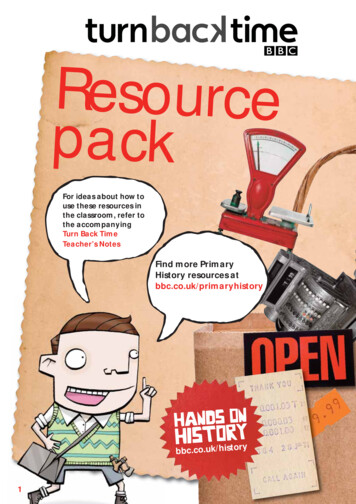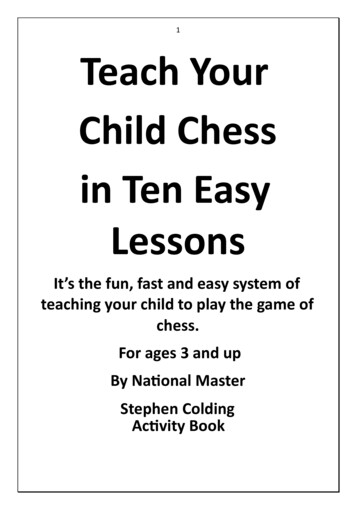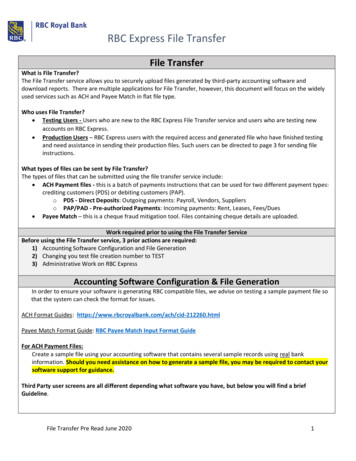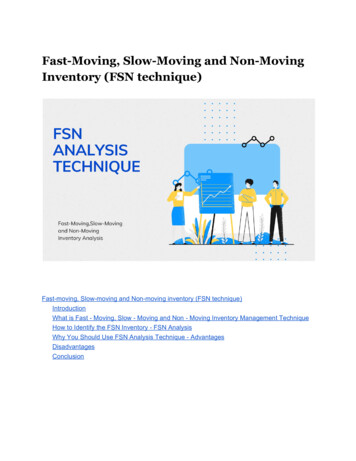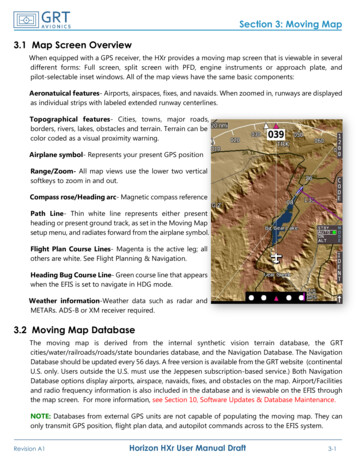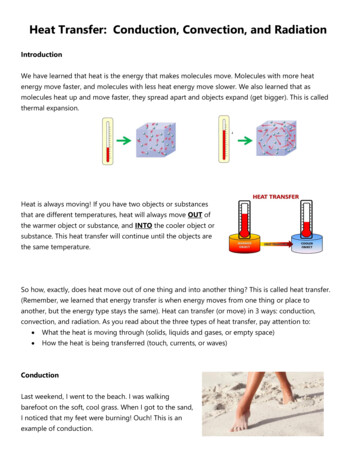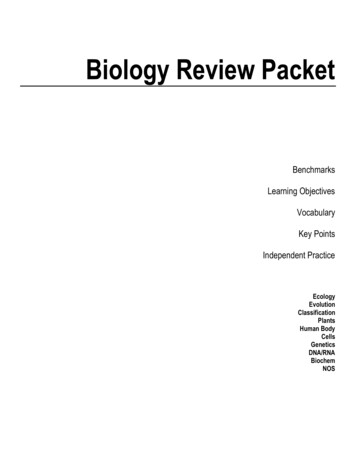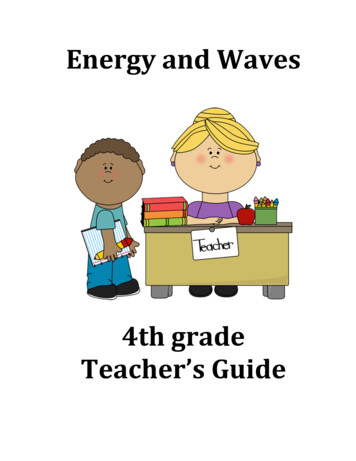
Transcription
EnergyandWaves4thgradeTeacher’sGuide
TransferofEnergyLesson 1:Lesson 2:Lesson 3:Lesson 4:Moving PenniesColored PaperLight BulbsGolf Ball / Ping Pong Ball
NGSS Lesson Planning: Fourth Grade-Moving PenniesGrade: 4thTopic: Transfer of EnergyBrief Lesson Description:Using pennies, students will demonstrate how energy can be transferred from one object toanother.Performance Expectation(s):4-PS3-1.Use evidence to construct an explanation relating the speed of an object to theenergy of that object.4-PS3-2. Make observations to provide evidence that energy can be transferred from placeto place by sound, light, heat, and electric currents.4-PS3-3. Ask questions and predict outcomes about the changes in energy that occur whenobjects collide.Specific Learning Outcomes:Students will work with pennies to develop questions and predict what happens whenobjects collide.Narrative / Background InformationThe faster a penny is moving, the more energy it possesses. When objects collide, energycan be transferred from one object to another, changing their motion.Prior Student Knowledge:What is energy?Science & Engineering Practices:Disciplinary Core Ideas:Crosscutting Concepts:PS3.A: Definitions of Energy The faster a given object is moving, themore energy it possesses. (4-PS3-1) Energy can be moved from place toplace by moving objects or throughsound, light, or electric currents. (4PS3-2),(4-PS3-3)PS3.B: Conservation of Energy and EnergyTransfer Energy is present whenever there aremoving objects, sound, light, or heat.When objects collide, energy can betransferred from one object toanother, thereby changing theirmotion. In such collisions, some energyis typically also transferred to thesurrounding air; as a result, the air getsheated and sound is produced. (4-PS32),(4-PS3-3)PS3.D: Energy in Chemical Processes andEveryday Life The expression “produce energy”typically refers to the conversion ofstored energy into a desired form forpractical use. (4-PS3-4) Asking questions (science) anddefining problems (engineering)Developing and using modelsPlanning and carrying outinvestigationsAnalyzing and interpreting dataUsing mathematics andcomputational thinkingConstructing explanations(science) and designing solutions(engineering)Engaging in argument fromevidenceObtaining, evaluating, andcommunicating informationLesson 1: Moving Pennies PatternsCause and effect: Mechanism andexplanationScale, proportion, and quantitySystems and system modelsEnergy and matter: Flows, cycles, andconservationStructure and functionStability and change
ETS1.A: Defining Engineering Problems Possible solutions to a problem arelimited by available materials andresources (constraints). The success ofa designed solution is determined byconsidering the desired features of asolution (criteria). Different proposalsfor solutions can be compared on thebasis of how well each one meets thespecified criteria for success or howwell each takes the constraints intoaccount. (secondary to 4-PS3-4)Possible Preconceptions/MisconceptionsLESSON PLAN – 5-E ModelENGAGE: Opening Activity – Access PriorLearning / Stimulate Interest / GenerateQuestionsBegin by discussing Energy. What do students know about energy? What do they want tolearn? Explain to the students that today we will be experimenting with some simpleeveryday items to demonstrate energy and motion.EXPLORE: Lesson Description – MaterialsNeeded / Probing or Clarifying QuestionsHave the students get into groups of two or three. Give each group seven pennies. Askthem to work together to demonstrate how energy can be used to create motion. Studentsrecord their demonstrations on paper or in their science notebooks.EXPLAIN: Concepts Explained andVocabulary DefinedIntroduce the concept of energy (energy – the ability to do work. There are different typesof energy. (potential - stored and kinetic - motion) Conservation of energy- energy cannotbe created or destroyed, it is transferred from one form to another.) Energy leads tomotion. Show Bill Nye Science video on Energy on YouTube 8 mins.)http://www.youtube.com/watch?v zTXW9aRO23YELABORATE: Applications and ExtensionsAfter watching the video and discussing the information above, the students are given theopportunity to refine their demonstrations from earlier. They can keep their previousexperiments or alter them. The teacher also poses one more challenge. Since energy canbe transferred through collisions, one of the groups demonstrations must show energytransfer through a collision. (If no experiments have done so, demonstrate to the studentshow you can spread the pennies out on the desk and flick on penny into the others. Themovement of the first penny will cause movement of the other pennies. Ask the studentswhat would happen if you were to flick the penny faster or softer?)EVALUATE:Formative Monitoring (Questioning /Discussion):After students are given a chance to experiment they present their demonstrations to theclass. In their demonstrations they must explain what they have learned about energy.Students also will turn in their notes from the day.Summative Assessment (Quiz / Project /Report):Elaborate Further / Reflect:Explain that moving forward the students will have more opportunity to experiment withenergy.
Materials Required for This ial Supplier (item #)Estimated Price 1.00
NGSS Lesson Planning: Fourth Grade-Colored PaperGrade: 4thTopic: Transfer of EnergyBrief Lesson Description:Using different colored paper, students will demonstrate how energy can be transferredfrom one object to another, by melting an ice cube.Performance Expectation(s):4-PS3-2. Make observations to provide evidence that energy can be transferred from placeto place by sound, light, heat, and electric currents.Specific Learning Outcomes:Students will work with ice cubes and different colored paper to develop observations thatprove energy can be transferred from the paper to the ice cube.Narrative / Background InformationDarker colored paper will be warmer as it absorbs more light.Prior Student Knowledge:Which colors would you rather wear on a warm day?Science & Engineering Practices:Disciplinary Core Ideas:Crosscutting Concepts: PS3.A: Definitions of Energy Energy can be moved from place toplace by moving objects or throughsound, light, or electric currents. (4PS3-2),(4-PS3-3)PS3.B: Conservation of Energy and EnergyTransfer Energy is present whenever there aremoving objects, sound, light, or heat.When objects collide, energy can betransferred from one object toanother, thereby changing theirmotion. In such collisions, some energyis typically also transferred to thesurrounding air; as a result, the air getsheated and sound is produced. (4-PS32),(4-PS3-3) Energy can also be transferred fromplace to place by electric currents,which can then be used locally toproduce motion, sound, heat, or light.The currents may have been producedto begin with by transforming theenergy of motion into electrical energy.(4-PS3-2),(4-PS3-4)PS3.D: Energy in Chemical Processes andEveryday Life The expression “produce energy”typically refers to the conversion ofstored energy into a desired form forpractical use. (4-PS3-4) Asking questions (science) anddefining problems (engineering)Developing and using modelsPlanning and carrying outinvestigationsAnalyzing and interpreting dataUsing mathematics and computationalthinkingConstructing explanations (science)and designing solutions (engineering)Engaging in argument from evidenceObtaining, evaluating, andcommunicating informationETS1.A: Defining Engineering ProblemsLesson 2: Colored Paper PatternsCause and effect: Mechanism andexplanationScale, proportion, and quantitySystems and system modelsEnergy and matter: Flows, cycles, andconservationStructure and functionStability and change
Possible solutions to a problem arelimited by available materials andresources (constraints). The success ofa designed solution is determined byconsidering the desired features of asolution (criteria). Different proposalsfor solutions can be compared on thebasis of how well each one meets thespecified criteria for success or howwell each takes the constraints intoaccount. (secondary to 4-PS3-4)Possible Preconceptions/MisconceptionsLESSON PLAN – 5-E ModelENGAGE: Opening Activity – Access PriorLearning / Stimulate Interest / GenerateQuestionsBegin by discussing Energy. What do students know about energy? What do they want tolearn? Explain to the students that today we will be experimenting with some simpleeveryday items to demonstrate how energy can be used for the purposes we have.EXPLORE: Lesson Description – MaterialsNeeded / Probing or Clarifying QuestionsHave the students get into groups of two or three. Give each group six different sheets ofcolored 3in by 3in sheets of paper (white, black, green, red, violet, yellow) and six small icecubes. Ask them to work together to predict which type of paper will cause the ice cube tomelt the quickest. The students then set their paper under heat lamps or in the sun and putan ice cube on each sheet. Students record their observations on paper or in their sciencenotebooks.EXPLAIN: Concepts Explained andVocabulary DefinedDiscuss with the students light and absorption. Follow the sion.docGo over the results of the experiments. Did groups arrive at similar results? If so why? Ifnot why not? Watch videos on how light travels and how it is absorbed.ELABORATE: Applications and ExtensionsAfter watching the video and discussing the information above, the students are given theopportunity to apply their knowledge to discover how light energy can be transferred intoheat energy. The students then experiment with their colored sheets of paper andthermometers to discover the transfer of energy. Follow the sion.docEVALUATE:Formative Monitoring (Questioning /Discussion):The students will reflect on their experiments from today and explain why it was possiblefor ice cube to melt, and where the energy came from to melt the ice cube.Summative Assessment (Quiz / Project /Report):Elaborate Further / Reflect:In the future if we want to use objects to heat objects, what colors would we wish to use?
Materials Required for This Lesson/ActivityQuantityDescriptionPotential Supplier (item #)Estimated Price1construction paper yellowAmazon.com 3.501construction paper redAmazon.com 41construction paper blackAmazon.com 51construction paper whiteAmazon.com 1.501construction paper greenAmazon.com 3.701construction paper violetAmazon.com 5
NGSS Lesson Planning: Fourth Grade-Light BulbsGrade: 4thTopic: Transfer of EnergyBrief Lesson Description:Using batteries, bulbs, wires, motors and hand cranks students will demonstrate howenergy can be transferred from one object to another.Performance Expectation(s):4-PS3-1.Use evidence to construct an explanation relating the speed of an object to theenergy of that object.4-PS3-2. Make observations to provide evidence that energy can be transferred from placeto place by sound, light, heat, and electric currents.Specific Learning Outcomes:Students will work with various materials to make observations that energy can betransferred from place to place.Narrative / Background InformationBatteries and hand cranks can be used to move electrons through a bulb to cause the bulbto light. For a bulb to light, you will need to create a circuit. The circuit must include a bulb,a battery and wire. The wire must connect the plus side of the battery to either the bottomor side metal on the bulb. The other wire must connect the the minus side of the batteryand to whichever metal side of the bulb was not touched earlier.Prior Student Knowledge:What is energy? Energy can be transferred.Science & Engineering Practices:Disciplinary Core Ideas:Crosscutting Concepts: PS3.A: Definitions of Energy The faster a given object is moving, themore energy it possesses. (4-PS3-1) Energy can be moved from place toplace by moving objects or throughsound, light, or electric currents. (4PS3-2),(4-PS3-3)PS3.B: Conservation of Energy and EnergyTransfer Energy is present whenever there aremoving objects, sound, light, or heat.When objects collide, energy can betransferred from one object toanother, thereby changing theirmotion. In such collisions, some energyis typically also transferred to thesurrounding air; as a result, the air getsheated and sound is produced. (4-PS32),(4-PS3-3) Energy can also be transferred fromplace to place by electric currents,which can then be used locally toproduce motion, sound, heat, or light.The currents may have been producedto begin with by transforming theenergy of motion into electrical energy.(4-PS3-2),(4-PS3-4)PS3.D: Energy in Chemical Processes andEveryday Life Asking questions (science) anddefining problems (engineering)Developing and using modelsPlanning and carrying outinvestigationsAnalyzing and interpreting dataUsing mathematics and computationalthinkingConstructing explanations (science)and designing solutions (engineering)Engaging in argument from evidenceObtaining, evaluating, andcommunicating informationLesson 3: Light Bulbs PatternsCause and effect: Mechanism andexplanationScale, proportion, and quantitySystems and system modelsEnergy and matter: Flows, cycles, andconservationStructure and functionStability and change
The expression “produce energy”typically refers to the conversion ofstored energy into a desired form forpractical use. (4-PS3-4)ETS1.A: Defining Engineering Problems Possible solutions to a problem arelimited by available materials andresources (constraints). The success ofa designed solution is determined byconsidering the desired features of asolution (criteria). Different proposalsfor solutions can be compared on thebasis of how well each one meets thespecified criteria for success or howwell each takes the constraints intoaccount. (secondary to 4-PS3-4)Possible Preconceptions/MisconceptionsLESSON PLAN – 5-E ModelENGAGE: Opening Activity – Access PriorLearning / Stimulate Interest / GenerateQuestionsBegin by reviewing Energy. What do students know about energy and its transfer? Whatdo they want to learn? Explain to the students that today we will be experimenting withelectrical energy.EXPLORE: Lesson Description – MaterialsNeeded / Probing or Clarifying QuestionsHave the students get into groups of two or three. Give each group a box of materials thatinclude four wires, two batteries, two bulbs, a hand crank and the appropriate holders. Askthem to work together to light a bulb. Students diagram their findings on paper or in theirscience notebooks.EXPLAIN: Concepts Explained andVocabulary DefinedIntroduce the concept of electrical circuits. What are the parts of the circuits and how dothey work? Discuss how the energy from the battery is transferred from the batterythrough the wires and into the bulb. Watch videos on circuits.http://www.youtube.com/watch?v VnnpLaKsqGUELABORATE: Applications and ExtensionsAfter watching the video and discussing the information above, the students are given theopportunity to refine their systems from earlier. They can keep their previous experimentsor alter them. The teacher also poses one more challenge, “Can the groups cause thebulb/bulbs to light up brighter or make them dimmer?”EVALUATE:Formative Monitoring (Questioning /Discussion):After students are given a chance to experiment they present their demonstrations to theclass. In their demonstrations they must explain what they have learned about energy andhow they were able to cause the bulbs to glow brighter and dimmer. Students also will turnin their notes from the day with a write up of their findings.Summative Assessment (Quiz / Project /Report):Elaborate Further / Reflect:Students work more the next few days with adding more and fewer bulbs and batteries intothe circuits to better their understanding of electrical energy. Teach the students aboutconductors and insulators using the lesson below.
Materials Required for This Lesson/ActivityQuantityDescriptionPotential Supplier (item #)Estimated Price2hand cranksAmazon.com 2450wiresElectrical Supply Set20bulbsElectrical Supply Set20battery holderElectrical Supply SetbatteriesLocal Dollar Storebulb holderElectrical Supply SetmotorsFrom Wheeled Vehicle KitbuzzersKelvin.com2010 10 9.50
Electricity: Circuits and ConductivityScientist’s Name:"What is electricity?"Electricity can be defined simply as the flow of a charged particle around a loop called a circuit. The chargedparticles flow much like water flows through a stream. This flow of charge particles is called electrical current orcurrent. The presence of an electrical current through a circuit allows for the circuit to perform work. Work is aterm used by physicists to describe the energy expended when a force is applied over a distance. When a currentis created the charged particles which are flowing around the circuit are said to be "doing work." This electricalwork can be used to power a light bulb or a simple engine."What is conductivity?"Why are the wires that power your television and toaster made from metal? The reason for this is that somematerials called conductors are able to carry an electrical current while others, insulators, cannot. Theconductivity, or measure of a materials current carrying ability, is based on properties inherent to that material.Conductors must have an available source of charged particles. As stated earlier, these charged particles are whatmake up an electrical current.Experiment 1: The Conductivity of SolidsYou will be testing the conductivity of solids. You will build a circuit tester using three wires, a battery and a bulb(see the picture below). You will also get a Ziploc bag containing test materials, a pair of safety glasses, your datacollection packet, and a pen or pencil. Check to make sure that you have everything you need.Instructions1. Put on your pair of safety glasses!
2. BEFORE BEGINNING TESTING, predict whether each item will light the bulb when you connect it to theelectrical circuit board. Write down your predictions in the 2nd column of the table below. (Need help deciding?Talk about it with your group members.)3. TESTING TIME!Connect items to the circuit using the red and black alligator clips. Observe what happens to thebulb.4. COLLECT DATA using the 3rd column. Did the bulb light?5. ANALYZE IT . Answer the first two questions in the Observations section. Think about your answers and whatthey tell you about each material’s conductivity, and about your answers to the first two questions.Test MaterialsPredictionsObservationsNailWoodPaper ClipPennyPing Pong BallMarbleAluminum FoilObservationsMake a list of the objects the lit the bulb and the ones that did not. What are some of the traits that thesematerials have in common? What are other items that you know of that you would predict to be conductors andinsulators?
NGSS Lesson Planning: Fourth Grade- Golf Ball/ Ping Pong BallGrade: 4thTopic: Transfer of EnergyBrief Lesson Description:Using golf ball and ping pong balls, the students will work to see how energy can betransferred from one object to another.Performance Expectation(s):4-PS3-2. Make observations to provide evidence that energy can be transferred from placeto place by sound, light, heat, and electric currents.4-PS3-3. Ask questions and predict outcomes about the changes in energy that occur whenobjects collide.Specific Learning Outcomes:Students will work with various materials to make observations that energy can betransferred from one object to another.Narrative / Background InformationWhen two balls are dropped one on top of the other, the ball on the bottom will transfer itsenergy to the ball on the top, causing the ball on top to bounce higher. This activity is agood example of one of the basic laws of physics; the Conservation of Momentum.In the collision of the golf ball with the ping pong ball the mass of the golf ball is muchgreater than the mass of the ping pong ball. In order for momentum to be conserved, thevelocity of the ping pong ball will be much greater.Adapted from: http://www.mcrel.org/whelmers/whelm22.aspPrior Student Knowledge:What is energy? Energy can be transferred. Students experience conservation ofmomentum with a baseball and bat. The much more massive bat imparts a greater velocityon the baseball.Science & Engineering Practices:Disciplinary Core Ideas:Crosscutting Concepts: PS3.A: Definitions of Energy The faster a given object is moving, themore energy it possesses. (4-PS3-1) Energy can be moved from place toplace by moving objects or throughsound, light, or electric currents. (4PS3-2),(4-PS3-3)PS3.B: Conservation of Energy and EnergyTransfer Energy is present whenever there aremoving objects, sound, light, or heat.When objects collide, energy can betransferred from one object toanother, thereby changing theirmotion. In such collisions, some energyis typically also transferred to thesurrounding air; as a result, the air getsheated and sound is produced. (4-PS32),(4-PS3-3) Energy can also be transferred fromplace to place by electric currents,which can then be used locally toproduce motion, sound, heat, or light.The currents may have been producedto begin with by transforming theenergy of motion into electrical energy.(4-PS3-2),(4-PS3-4) Asking questions (science) anddefining problems (engineering)Developing and using modelsPlanning and carrying outinvestigationsAnalyzing and interpreting dataUsing mathematics and computationalthinkingConstructing explanations (science)and designing solutions (engineering)Engaging in argument from evidenceObtaining, evaluating, andcommunicating informationLesson 4: Golf Ball / Ping Pong Ball PatternsCause and effect: Mechanism andexplanationScale, proportion, and quantitySystems and system modelsEnergy and matter: Flows, cycles, andconservationStructure and functionStability and change
PS3.D: Energy in Chemical Processes andEveryday Life The expression “produce energy”typically refers to the conversion ofstored energy into a desired form forpractical use. (4-PS3-4)PS3.C: Relationship Between Energy andForces When objects collide, the contactforces transfer energy so as to changethe objects’ motions. (4-PS3-3)ETS1.A: Defining Engineering Problems Possible solutions to a problem arelimited by available materials andresources (constraints). The success ofa designed solution is determined byconsidering the desired features of asolution (criteria). Different proposalsfor solutions can be compared on thebasis of how well each one meets thespecified criteria for success or howwell each takes the constraints intoaccount. (secondary to 4-PS3-4)Possible Preconceptions/MisconceptionsLESSON PLAN – 5-E ModelENGAGE: Opening Activity – Access PriorLearning / Stimulate Interest / GenerateQuestionsBegin by discussing Energy. What do students know about energy? What do they want tolearn? Explain to the students that today we will be experimenting with some simpleeveryday items – a golf ball and a ping pong ball - to demonstrate energy and motion.EXPLORE: Lesson Description – MaterialsNeeded / Probing or Clarifying QuestionsThis activity works best on a concrete or hard tile floor. A large concrete block can be placedon a carpeted floor. Before dropping either of the balls, ask students to predict how higheach will bounce. Use tape on the wall to mark the height of each bounce. Have thestudents get into groups of two or three. Give each group materials that include one golfball and one ping pong ball. After the initial drop of the ping pong ball, ask students howthe ball can be made to bounce higher (e.g. Drop the balls from a higher point). (The ballscannot be thrown down). Students diagram their findings on paper or in their sciencenotebooks. Relate to students that each response is an example of adding more energy tothe ping pong ball. Suggest to students that you will transfer energy from the golf ball tothe ping pong ball. Ask them if they think it is possible to transfer energy from one thing toanother. Ask for examples (kicking a soccer ball, hammering a nail, etc.).EXPLAIN: Concepts Explained andVocabulary DefinedHave the students explain their results. Ask students to explain where the energy camefrom that caused the ping pong ball to bounce so high (golf ball). Discuss how energy canbe transferred from one object to another. Encourage them to experiment withtransferring energy from one ball to the other. Ask them to explain what must havehappened to the golf ball if it did transfer some of its energy to the ping pong ball (itbounced lower than before). Did any of them observe the lower bounce of the golf ballduring the first test? (Most follow the more interesting flight of the ping pong ball.) Relateto students that scientists must learn to be keenly observant.Share this video:http://www.youtube.com/watch?v XNqUnGT1qDEhttp://www.youtube.com/watch?v QfRXBAgIzwY
Vocabulary: Momentum, Inertia, GravityELABORATE: Applications and ExtensionsAfter discussing the information above, the students are given the opportunity to refinetheir systems from earlier. Direct them to make careful observations and measurements asyou repeatedly drop both balls. Use tape strips to indicate the height of different bounces.The students can also work with different types of balls and record their results. They cankeep their previous experiments or alter them. The teacher also poses one more challenge:Can you drop the same ball from the same height, but make it bounce higher?Collect balls of various sizes and masses. Some balls which could be used are baseballs,large ball bearings, small rubber balls and other ping pong balls. Students should predictwhich ball will allow the ping pong ball to bounce higher when the activity is repeated.Repeat the activity and compare the predictions to the outcomes.EVALUATE:Formative Monitoring (Questioning /Discussion):Summative Assessment (Quiz / Project /Report):Elaborate Further / Reflect:After students are given a chance to experiment they present their demonstrations to theclass. In their demonstrations they must explain what they have learned about energy andhow they were able to cause the ball to bounce higher. Students also will turn in theirnotes from the day with a write up of their findings.Students work more the next few days with trying to get balls to bounce higher by onlydropping them.
Materials Required for This Lesson/ActivityQuantityDescriptionPotential Supplier (item #)Golf BallsFrom other experimentsPing Pong BallsFrom other experimentsTennis BallsFrom other experimentsEstimated Price
SpeedandEnergyLesson 5: Dropper PopperLesson 6: Energy of the PlaygroundLesson 7: Let’s Build a RocketLesson 8: Marble MountainsLesson 9: Stomp RocketsLesson 10: Sound and MovementLesson 11: Data Transfer
NGSS Lesson Planning: Fourth Grade-Dropper PoppersGrade: 4thTopic: Speed and EnergyBrief Lesson Description:Using dropper poppers, the students will work to see how speed and energy are related.Performance Expectation(s):4-PS3-1. Use evidence to construct an explanation relating the speed of an object to theenergy of that object.4-PS3-2. Make observations to provide evidence that energy can be transferred from placeto place by sound, light, heat, and electric currents.Specific Learning Outcomes:Students will work with various materials to make observations that speed is related to theamount of energy in an object.Narrative / Background InformationDropping the poppers from different heights will cause them to bounce to different levels.Prior Student Knowledge:What is energy? Energy can be transferred.Science & Engineering Practices:Disciplinary Core Ideas:Crosscutting Concepts: PS3.A: Definitions of Energy The faster a given object is moving, themore energy it possesses. (4-PS3-1) Energy can be moved from place toplace by moving objects or throughsound, light, or electric currents. (4PS3-2),(4-PS3-3)PS3.B: Conservation of Energy and EnergyTransfer Energy is present whenever there aremoving objects, sound, light, or heat.When objects collide, energy can betransferred from one object toanother, thereby changing theirmotion. In such collisions, some energyis typically also transferred to thesurrounding air; as a result, the air getsheated and sound is produced. (4-PS32),(4-PS3-3)PS3.D: Energy in Chemical Processes andEveryday Life The expression “produce energy”typically refers to the conversion ofstored energy into a desired form forpractical use. (4-PS3-4)PS3.C: Relationship Between Energy andForces When objects collide, the contactforces transfer energy so as to changethe objects’ motions. (4-PS3-3) Asking questions (science) anddefining problems (engineering)Developing and using modelsPlanning and carrying outinvestigationsAnalyzing and interpreting dataUsing mathematics and computationalthinkingConstructing explanations (science)and designing solutions (engineering)Engaging in argument from evidenceObtaining, evaluating, andcommunicating informationETS1.A: Defining Engineering Problems Possible solutions to a problem arelimited by available materials andresources (constraints). The success ofLesson 5: Dropper Poppers PatternsCause and effect: Mechanism andexplanationScale, proportion, and quantitySystems and system modelsEnergy and matter: Flows, cycles, andconservationStructure and functionStability and change
a designed solution is determined byconsidering
NGSS Lesson Planning: Fourth Grade-Colored Paper Grade: 4th Topic: Transfer of Energy Lesson 2: Colored Paper Brief Lesson Description: Using different colored paper, students will demonstrate how energy can be transferred from one object to another, by melting an ice cube.
